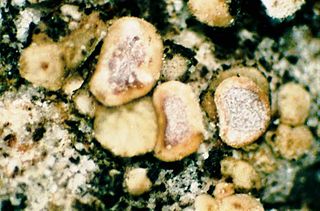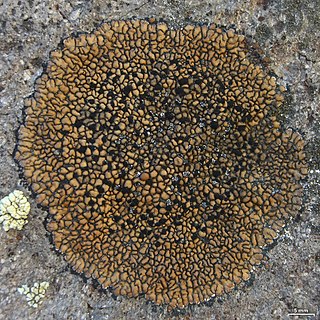
The Leotiomycetes are a class of ascomycete fungi. Many of them cause serious plant diseases.

Diaporthales is an order of sac fungi.

The Dactylosporaceae or Sclerococcaceae are a family of lichen-forming fungi in the class Eurotiomycetes. It is the only family of the order Sclerococcales and subclass Sclerococcomycetidae.

The Acarosporales are an order of fungi in the class Lecanoromycetes. Phylogenetic analyses conducted using the sequences of both the protein-coding gene RPB2 as well as nuclear ribosomal genes place this order within the subclass Acarosporomycetidae.

The Pyrenulales are an order of ascomycetous fungi within the class Eurotiomycetes and within the subphylum Pezizomycotina.
Rhizomucor is a genus of fungi in the family Lichtheimiaceae. The widespread genus contains six species. Rhizomucor parasiticus, the species originally selected as the type, is now considered synonymous with Rhizomucor pusillus.

Ptychographa is a genus of lichenized fungi in the family Xylographaceae. It is a monotypic genus, containing the single species Ptychographa xylographoides. Both the species and genus were described as new in 1874 by Finnish botanist William Nylander.
Lignoscripta is a genus of lichenized fungi in the family Trapeliaceae. This is a monotypic genus, containing the single species Lignoscripta atroalba.
Amylora is a genus of lichenized fungi in the family Trapeliaceae. This is a monotypic genus, containing the single species Amylora cervinocuprea.
Squamella is a genus of lichenized fungi in the family Cladoniaceae. The genus is monotypic, containing the single species Squamella spumosa, which is found in Australia. Both the genus and species were described by Samuel Hammer in 2001.
Mazaediothecium is a genus of calicioid lichens in the family Pyrenulaceae. It has four species. The genus was circumscribed by Dutch lichenologist André Aptroot in 1991, with Mazaediothecium rubiginosum assigned as the type species.

Diploicia is a genus of lichenized fungi in the family Caliciaceae. The genus has a widespread distribution, especially in temperate regions, and contains 6 species.
Bogoriella is a genus of crustose lichens in the family Trypetheliaceae. The genus was circumscribed by Alexander Zahlbruckner in 1928, with Bogoriella subpersicina assigned as the type species. It was later shown that Bogoriella was an older name for Mycomicrothelia, and so all of the species that were in that genus needed to be transferred to Bogoriella.
Meliola is a large genus of fungi in the family Meliolaceae. It was circumscribed by Swedish mycologist Elias Magnus Fries in 1825.
Semigyalecta is a genus of lichenized fungi in the family Gyalectaceae. It is a monotypic genus, containing the single species Semigyalecta paradoxa, described as new to science in 1921 by Finnish lichenologist Edvard August Vainio.

The Ophioparmaceae are a small family of lichen-forming fungi in the order Umbilicariales. The family was circumscribed in 1988 by lichenologists Roderick Westgarth Rogers and H. Thorsten Lumbsch.

Architrypethelium is a genus of lichen-forming fungi in the family Trypetheliaceae. The genus was circumscribed in 1991 by Dutch lichenologist André Aptroot, with A. seminudum assigned as the type species. It is a segregate of genus Trypethelium.
Neopsoromopsis is a genus of lichen-forming fungi of uncertain familial placement in the order Lecanorales. The genus is monotypic, containing the single species Neopsoromopsis argentina, found in Argentina. Both the genus and species were described by Hungarian lichenologist Vilmos Kőfaragó-Gyelnik in 1940.
Xyleborus is a genus of lichen-forming fungi in the family Stereocaulaceae. It has two species. The genus was circumscribed in 2009 by Richard C. Harris and Douglas Ladd with Xyleborus sporodochifer assigned as the type species. A second species, X. sporodochifer, was added to the genus in 2015.

The Lecideales are an order of lichenized fungi in the class Lecanoromycetes. The order contains two families: the Lecideaceae, which contains 29 genera and about 260 species, and Lopadiaceae, which contains the single genus Lopadium of 10 species.










